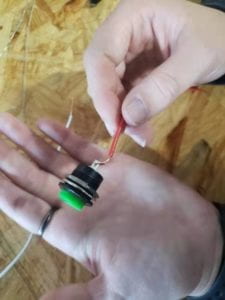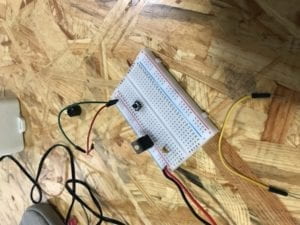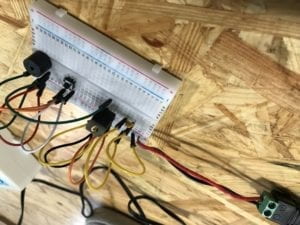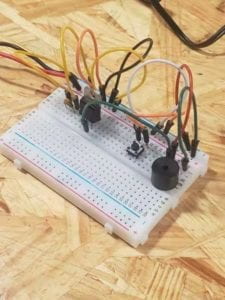Introduction:
The assignment for the first Interaction Lab Recitation was to follow the provided schematics of basic circuits and then build them.
Objectives:
- Learn how to read a circuit diagram
- Complete the circuits
- Learn to Solder
- Create a button comprised of button and soldered wires
Materials (as listed on the IMA website):
- 1 * Breadboard
- 1 * LM7805 Voltage Regulator
- 1 * Buzzer
- 1 * Push-Button Switch
- 1 * Arcade Button
- 1 * 220 ohm Resistor
- 1 * 10K ohm Resistor
- 1 * 10K ohm Variable Resistor (Potentiometer)
- 1 * LED
- 1 * 100 nF (0.1uF) Capacitor
- 1 * 12 volt power supply
- 1 * Barrel Jack
- 1 * Multimeter
- Several Jumper Cables (Hook-up Wires)
Process:
Before we began to work with the circuits, we learned from Marcela how to solder where we then soldered wires to a button. We were able to complete objective 3 and 4 with no problems.



After the successful creation of our battery, we went on to begin our circuits. This section was less fruitful. Initially, we came to a pause trying to figure how to finish the circuit loop and “ground” it.



We struggled time-wise to complete our circuits and were unable to complete the other two circuits. Through the assistants of learning assistance we were able to understand all the appropriate wiring and complete our circuit.
Reflection:
I am disappointed that it took us so long to complete the first circuit and therefore were unable to work on the other ones and experiment without own ideas. It has been well over four years since I have worked with a breadboard and I was a busy rusty. I really enjoyed getting to work with the components and refreshing my memory of how to build a working circuit and look forward to building more (and my own designs) in the future!
Questions:
- After reading The Art of Interactive Design, I think that the component of the circuit that includes the switch or button includes interactivity because the functions of the circuits depends on how we interact with them thus defining interactivity.
- In Zach Lieberman’s talk about interactive art makes me think that if our work has the ability to change function based on human act, then were are therefore creating an “interaction” and thus interactive art. In his case, he uses the input movements of his hands to move the art which outputs the art moving. We create interactive art when we combine in the human or some other real work action in which the end product varies based on initial action.